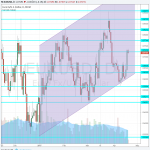U.S. futures and European stocks are modestly lower, following a mostly green Asian session, amid growing jitters over today’s 2 pm announcement by President Trump in which he will unveil the fate of the Iran nuclear deal.

Ahead of Trump’s much anticipated announcement this afternoon, it has been a case of sell the rumor and the news (for reasons Barclays explained overnight), with oil prices retreating from three-and-a-half year highs as investors weighed competing views on whether the U.S. will reimpose sanctions on OPEC producer Iran and the potential consequences of such a decision: as Bloomberg recaps, while foreign officials and analysts say Trump is likely to remove the U.S. from the pact, the president may also surprise allies by agreeing to stay in the accord a while longer as American and European diplomats forge side deals aimed at addressing his concerns.
As a result, there was some profit-taking as WTI dipped back under $70.00/bbl level following reports that European powers are close to a package deal to try and persuade Trump not to withdraw from the Iran deal; however, subsequent reports suggest that Trump may be inclined to dropping out of the agreement when he announces his decision at 2 pm ET today.

Complicating matters, the potential fallout from a US withdrawal in the oil market is unclear. While consultant FGE is among industry watchers who have said renewed U.S. measures may cut production from OPEC’s third-largest member, Barclays Plc sees Iran’s output little changed in 2018, while RBC notes that “Iran’s exports could be cut by 200K bpd to 300K bpd” if the US restores sanctions. How European and Asian oil buyers deal with possible American action, as well as the effect on OPEC’s output curbs aimed at shrinking a global glut, will also be watched.
“Reaching the $70 milestone gave investors a sense of accomplishment and triggered profit-taking,” Satoru Yoshida, a commodity analyst at Rakuten Securities Inc., said by phone from Tokyo. Still, “oil is trading around $70 as the market is factoring in the possibility that the U.S. will unilaterally terminate the Iran deal and reimpose sanctions.”
Overnight Barclays explained overnightof how we got here, and what happens next:

There was less confusion about the dollar, which continued its torrid surge since the April 17 PBOC RRR cut, rallying steadily for most of the overnight session across G-10 with the DXY hitting another high for 2018; meanwhile no fresh comments from Fed Chair Powell who spoke early in Zurich and hinted that EMs are on their own, led to a continuation of recent trend. The dollar climbed after erasing an earlier decline. The Bloomberg Dollar Spot Index rose for a third day to reach its highest level since December.

Across other G-10 currencies, the biggest slide was seen in the Canadian dollar, followed by fellow commodity currency the Australian dollar. Sterling headed for its lowest level versus the dollar since January on dismal U.K. house price data. The euro felt the heat from Italian politics, dropping to 1.1874, a new year-to-date low, while Sweden’s krona saw the biggest daily advance as the Riksbank’s minutes and policymaker comments were taken as more hawkish than markets had expected.
Meanwhile, as Bloomberg macro commentator and former Lehman trader Mark Cudmore writes, “all bullish biases neutralize amid widespread EM weakness, even PHP despite it having best overall long-term fundamentals.” Not helping ease concerns about growing turmoil among emerging markets, was Fed Chair Jerome Powell who warned that the Fed’s gradual push towards higher interest rates shouldn’t be blamed for any roiling of emerging market economies, which are well placed to navigate the tightening of U.S. monetary policy.
In a speech delivered in Zurich, the Fed chair argued U.S. decision-making isn’t the major determinant of flows of capital into developing economies, and that the influence of the Fed on global financial conditions should not be overstated, despite being blamed five years ago for the so-called taper tantrum.
“There is good reason to think that the normalization of monetary policy in advanced economies should continue to prove manageable for EMEs,” Powell said at a conference sponsored by the International Monetary Fund and Swiss National Bank in Zurich on Tuesday. “Markets should not be surprised by our actions if the economy evolves in line with expectations.”
The result: another “sea of red” day in today’s EM FX monitor.

Global equities largely followed these two concerns, with Europe’s Stoxx 600 down 0.5% amid broad risk aversion ahead of Trump’s decision on the Iranian nuclear deal later in the day. The FTSE (+0.1%) currently outperforming as UK traders return to their desks post-bank holiday, as well as being given a boost by Takeda’s GBP 46bln approach for Shire (+4.1%). FTSEMIB (-2.2%) is the worst performer due to election concerns, with the DAX (-0.4%) also underperforming, following an earnings miss for Deutsche Post (-6.1%).
Earlier, Asian equity markets traded mostly in the green, catching up with a strong Monday close on Wall Street where all 3 majors indexes closed in the green but off best levels after a late retreat in crude, while mixed Chinese trade data and a looming Trump announcement on the Iran agreement has also kept upside in the region contained. ASX 200 (+0.1%) is positive with gains led by strength in the largest weighted financials sector. Elsewhere, Nikkei 225 (+0.2%) shrugged off a firmer currency and conformed to the overall risk appetite, while Hang Seng (+1.4%) and Shanghai Comp. (+0.8%) outperformed with healthcare and financials front-running the gains despite further liquidity inaction and another consecutive net neutral position by the PBoC.














Leave A Comment